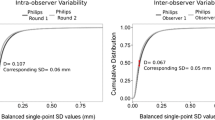Abstract
A pragmatic method for assessing the accuracy and precision of a given processing pipeline required for converting computed tomography (CT) image data of bones into representative three dimensional (3D) models of bone shapes is proposed. The method is based on coprocessing a control object with known geometry which enables the assessment of the quality of resulting 3D models. At three stages of the conversion process, distance measurements were obtained and statistically evaluated. For this study, 31 CT datasets were processed. The final 3D model of the control object contained an average deviation from reference values of −1.07 ± 0.52 mm standard deviation (SD) for edge distances and −0.647 ± 0.43 mm SD for parallel side distances of the control object. Coprocessing a reference object enables the assessment of the accuracy and precision of a given processing pipeline for creating CT-based 3D bone models and is suitable for detecting most systematic or human errors when processing a CT-scan. Typical errors have about the same size as the scan resolution.



Similar content being viewed by others
References
Messmer P, Matthews F, Jacob AL, Kikinis R, Regazzoni P, Noser H: A CT-database for research, development and education: concept and potential. J Digit Imaging 20(1):17–22, 2007
Schmutz B, Wullschleger ME, Schuetz MA: The effect of CT slice spacing on the geometry of 3D models. In: Proceedings of 6th Australian Biomechanics Conference. New Zealand: The University of Auckland, 2007, pp 93–94
Shin J, Lee HK, Choi CG, et al: The quality of reconstructed 3D images in multidetector-row helical CT: experimental study involving scan parameters. Korean J Radiol 3(1):49–56, 2002
Souza A, Udupa JK, Saha PK: Volume rendering in the presence of partial volume effects. IEEE Trans Med Imaging 24(2):223–235, 2005
Ward KA, Adams JE, Hangartner TN: Recommendations for thresholds for cortical bone geometry and density measurement by peripheral quantitative computed tomography. Calcif Tissue Int 77:275–280, 2005
Stalling D, Zöckler M, Hege HC: Interactive segmentation of 3D medical images with subvoxel accuracy. CAR 98:137–142, 1998
Drapikowski P: Surface modeling—uncertainty estimation and visualization. Comput Med Imaging Graph 32:134–139, 2008
Cignoni P, Rocchini C, Scopigno R: Metro: measuring error on simplified surfaces. Comput Graph Forum 17(2):167–174, 1998
Bade R, Haase J, Preim B: Comparison of fundamental mesh smoothing algorithms for medical surface models. In: Schulze T, Schlechtweg S, Hinz V Eds. Simulation und Visualisierung. SCS European Publishing House, Erlangen, 2006, pp 289–304
Piegl L, Tiller W: The NURBS Book. Springer, Berlin, 1997
Author information
Authors and Affiliations
Corresponding author
Rights and permissions
About this article
Cite this article
Noser, H., Heldstab, T., Schmutz, B. et al. Typical Accuracy and Quality Control of a Process for Creating CT-Based Virtual Bone Models. J Digit Imaging 24, 437–445 (2011). https://doi.org/10.1007/s10278-010-9287-4
Published:
Issue Date:
DOI: https://doi.org/10.1007/s10278-010-9287-4




